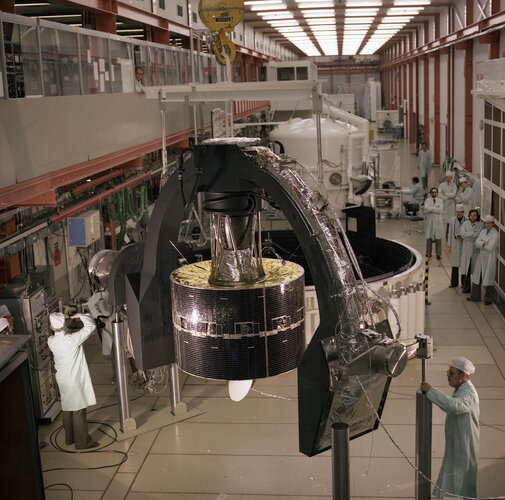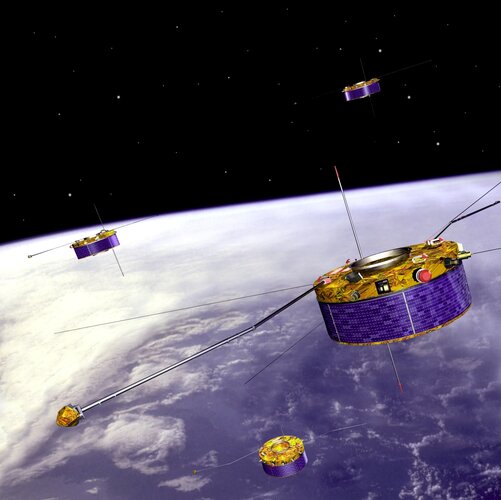Polka Dots and Sunbeams: Sol 4078
Friday, 26 January 2024 21:10 Earth planning date: Wednesday, January 24, 2024: We arrived at a workspace with bedrock delightfully dotted with resistant features whose granular appearance and gray color were intriguing enough to warrant attention from APXS, ChemCam, and MAHLI.
ChemCam will target one of these features, "Tehipite Dome," while MAHLI and APXS will target a different feature on the same block, "Sierra Col
Earth planning date: Wednesday, January 24, 2024: We arrived at a workspace with bedrock delightfully dotted with resistant features whose granular appearance and gray color were intriguing enough to warrant attention from APXS, ChemCam, and MAHLI.
ChemCam will target one of these features, "Tehipite Dome," while MAHLI and APXS will target a different feature on the same block, "Sierra Col Satellite communications for safer and greener aviation
Friday, 26 January 2024 13:18
The first commercial flights of a programme that uses Iris satellite technology to help modernise air traffic management and reduce carbon emissions have taken place.
Week in images: 22-26 January 2024
Friday, 26 January 2024 13:15
Week in images: 22-26 January 2024
Discover our week through the lens
Earth views from Cupola by Marcus Wandt
Friday, 26 January 2024 12:00 Video:
00:01:25
Video:
00:01:25
Join ESA project astronaut Marcus Wandt inside the seven-windowed cupola, the International Space Station's "window to the world".
The ESA - European Space Agency-built Cupola is the favourite place of many astronauts on the International Space Station. It serves not only as a unique photo spot, but also for observing robotic activities of the Canadian Space Agency's robotic arm Canadarm2, arriving spacecraft and spacewalks.
Marcus was launched to the International Space Station on the Dragon spacecraft as part of Axiom Mission 3 on 18 January 2024. His two-week mission on board is known as Muninn.
Follow Marcus’s journey on the
Earth from Space: Snow-bound eastern US
Friday, 26 January 2024 08:00 Image:
Record-breaking Arctic cold weather has swept through much of the United States in the last few weeks. The eastern part of the country was particularly affected with thick snow blanketing most of the region, as this Copernicus Sentinel-3 image shows.
Image:
Record-breaking Arctic cold weather has swept through much of the United States in the last few weeks. The eastern part of the country was particularly affected with thick snow blanketing most of the region, as this Copernicus Sentinel-3 image shows. NASA helicopter's mission ends after three years on Mars
Friday, 26 January 2024 06:36 NASA's Ingenuity Mars helicopter, which made history by achieving the first powered flight on another world, has officially ended its nearly three-year mission after sustaining rotor damage during its last outing, the space agency said Thursday.
The tissue-box sized aircraft, which hitched a ride to the Red Planet under the belly of the Perseverance rover, first lifted off the surface on A
NASA's Ingenuity Mars helicopter, which made history by achieving the first powered flight on another world, has officially ended its nearly three-year mission after sustaining rotor damage during its last outing, the space agency said Thursday.
The tissue-box sized aircraft, which hitched a ride to the Red Planet under the belly of the Perseverance rover, first lifted off the surface on A Venus and gravitational wave missions get EU green light
Friday, 26 January 2024 06:36 The European Space Agency gave the green light to two missions on Thursday, one to detect ripples in spacetime called gravitational waves and another to probe the secrets of Earth's closest neighbouring planet Venus.
The Laser Interferometer Space Antenna (LISA) will become the first mission to study gravitational waves from space, with a planned 2035 launch on an Ariane 6 rocket, the ESA sa
The European Space Agency gave the green light to two missions on Thursday, one to detect ripples in spacetime called gravitational waves and another to probe the secrets of Earth's closest neighbouring planet Venus.
The Laser Interferometer Space Antenna (LISA) will become the first mission to study gravitational waves from space, with a planned 2035 launch on an Ariane 6 rocket, the ESA sa JAXA says SLIM landing successful, deploys robots to surface
Friday, 26 January 2024 06:36 Japan's Smart Lander for Investigating the Moon, or SLIM, landed on the moon Saturday about 180 feet, or little more than half a football field, away from its target landing spot, space officials said on Thursday.
The Japan Aerospace Exploration Agency said its landing technology allowed SLIM to land within 330 feet of the targeting landing location, calculating for obstacle avoidance m
Japan's Smart Lander for Investigating the Moon, or SLIM, landed on the moon Saturday about 180 feet, or little more than half a football field, away from its target landing spot, space officials said on Thursday.
The Japan Aerospace Exploration Agency said its landing technology allowed SLIM to land within 330 feet of the targeting landing location, calculating for obstacle avoidance m NASA's Scout System successfully predicts small asteroid impact over Germany
Friday, 26 January 2024 06:36 In a recent demonstration of NASA's advancing planetary defense capabilities, a small asteroid, approximately 3 feet (1 meter) in size, disintegrated harmlessly over Germany. This event occurred on Sunday, Jan. 21, at 1:32 a.m. local time (CET). Notably, NASA's Scout impact hazard assessment system provided a 95-minute advance warning of the asteroid's impact trajectory, marking this event as th
In a recent demonstration of NASA's advancing planetary defense capabilities, a small asteroid, approximately 3 feet (1 meter) in size, disintegrated harmlessly over Germany. This event occurred on Sunday, Jan. 21, at 1:32 a.m. local time (CET). Notably, NASA's Scout impact hazard assessment system provided a 95-minute advance warning of the asteroid's impact trajectory, marking this event as th Spain's PLD Space Selected for European Institutional Space Launch Contracts
Friday, 26 January 2024 06:36 In a significant development for the European space sector, PLD Space, a Spain-based aerospace company, has been chosen by the European Space Agency (ESA) and the European Commission (EC) to participate in the prestigious Flight Ticket Initiative. This program is designed to form a consortium of private launch providers to cater to the space access demands of European institutions.
PLD Spa
In a significant development for the European space sector, PLD Space, a Spain-based aerospace company, has been chosen by the European Space Agency (ESA) and the European Commission (EC) to participate in the prestigious Flight Ticket Initiative. This program is designed to form a consortium of private launch providers to cater to the space access demands of European institutions.
PLD Spa New Findings from Ryugu Samples Reveal Cometary Organic Matter
Friday, 26 January 2024 06:36 In a recent development that adds another layer to our understanding of the solar system's complexity, researchers have uncovered intriguing evidence from the asteroid Ryugu. This near-Earth asteroid, which came into the spotlight following the successful Hayabusa2 mission by the Japan Aerospace Exploration Agency (JAXA), continues to offer rich insights, particularly about the presence and tran
In a recent development that adds another layer to our understanding of the solar system's complexity, researchers have uncovered intriguing evidence from the asteroid Ryugu. This near-Earth asteroid, which came into the spotlight following the successful Hayabusa2 mission by the Japan Aerospace Exploration Agency (JAXA), continues to offer rich insights, particularly about the presence and tran PowerLight Technologies Joins Forces with Blue Origin for DARPA's LunA-10 Lunar Power Project
Friday, 26 January 2024 06:36 In a significant development for lunar exploration and power infrastructure, PowerLight Technologies, a leader in long-distance wireless power beaming, has announced its collaboration with aerospace company Blue Origin under the DARPA Lunar Architecture (LunA-10) initiative. This partnership marks a pivotal step in developing scalable surface power infrastructure for lunar services, utilizing lu
In a significant development for lunar exploration and power infrastructure, PowerLight Technologies, a leader in long-distance wireless power beaming, has announced its collaboration with aerospace company Blue Origin under the DARPA Lunar Architecture (LunA-10) initiative. This partnership marks a pivotal step in developing scalable surface power infrastructure for lunar services, utilizing lu Study predicts best times for 'Curiosity' to sample Mars' methane
Friday, 26 January 2024 06:36 Since methane was first detected in Mars' atmosphere 20 years ago, scientists have struggled to uncover its origins and how it is transported around the Red Planet. Measurements from atmospheric samples collected by NASA's Curiosity rover at Gale crater reveal fluctuations in methane levels over days and seasons, but pinpointing the timing and reasons for the variability has proved difficult.
Since methane was first detected in Mars' atmosphere 20 years ago, scientists have struggled to uncover its origins and how it is transported around the Red Planet. Measurements from atmospheric samples collected by NASA's Curiosity rover at Gale crater reveal fluctuations in methane levels over days and seasons, but pinpointing the timing and reasons for the variability has proved difficult. 

 Image:
Space: 1977
Image:
Space: 1977 